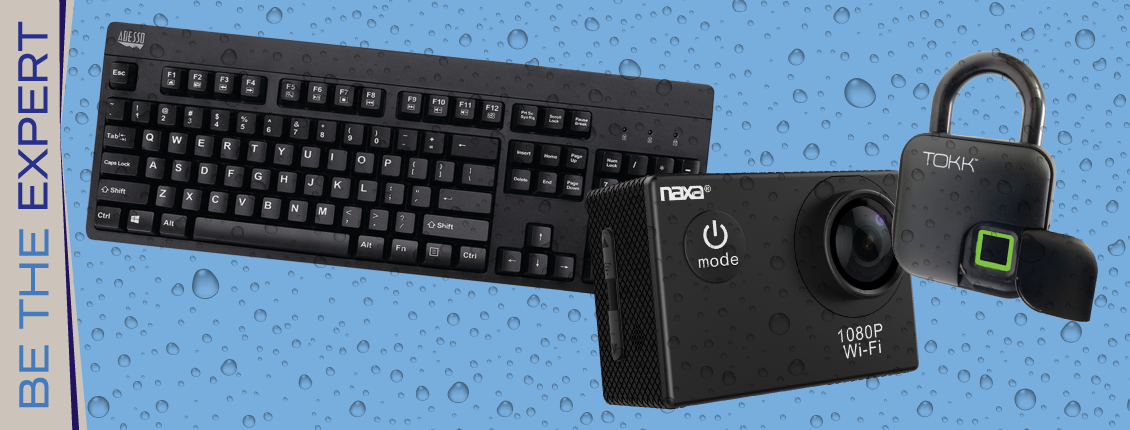
Updated March 10, 2022
Hint: Navigating the differences can be tricky
A key selling point for many electronics and accessories is that wonderful buzzword—waterproof. Smartphones have quickly adopted waterproof ratings to stay at the cutting edge, and smartphone cases usually keep it front and center. Plus, portable speakers, 2-way radios, specialty cases, outdoor security cameras, and other devices are denoted as either water-resistant or waterproof. More troublingly, sometimes both terms are used for the same product. Other terms bandied about are splashproof, sweatproof, weatherproof, and rainproof.
To be clear, most of these so-called water-something devices are not wholly waterproof. They can only withstand certain levels of water pressure.
Let’s dive into the details.
Waterproof ratings
There are lots of acronyms used to codify resistance to water. And they are not consistently used across manufacturers, devices, or brands. In our Military Grade MIL-STD blog, we touched on the IP scale. But there are other standards too when it comes to water—JIS and ATM. So, let’s explore them all.
The standards of water resistance
There are three different standards that an item can be marked with to signify its level of resistance to moisture, dust, and other water pressure—Ingress Protection marking (IP), Japanese Industrial Standard (JIS), and Atmospheres (ATM). The manufacturer tests their product to one of these standards to determine what level of water- or elemental-exposure it can withstand. Which specific standard they choose to use is up to them. And to be clear, just because it was tested doesn’t mean it passed!
Plus, a manufacturer doesn’t always use the same standard for all their products. Garmin, for example, uses a mixed bag of terms. They will note how deep their product can go, or list an ATM rating, or at the minimum, specify general usage like swimming. Sometimes they will also list which MIL-STD it is supposed to meet. As noted above, MIL-STD uses the IP system.
Therefore, for more information about Garmin’s water ratings, their website provides additional information.
Water-Resistance According to IP, JIS, and ATM
JIS:

ATM:
ATM is the abbreviation for Atmospheres—a depth rating as to how much pressure a device can withstand below sea level. These numbers are theoretical because most devices aren’t really taken that deep. Ratings are determined by “being sprayed with a stream of water that gives the equivalent of their rated water resistance.”
Plus, the length of exposure time is brief. Nor does the stream exert equal pressure all the way around.
The number given with an ATM rating is in atmospheric bars. So, it’s a depth rating. 1 is sea level. The bigger the number, the deeper an object can survive increasing water pressure. 3 ATM means a resistance to the depth of 30 meters, 5 to 50 meters, and so on.
Here’s how ATM works out in terms of practical usage:

IP:
The IP scale is a bit more complex. It looks at the ingress of solids and liquids. The first number in the IP tag (IP1X) references solids. The second number, liquids (IPX7). Some devices may only contain one or the other, or both.

Keep in mind that although a device may be labeled at the highest rating possible on a particular standards chart, it may not have been tested at the lower levels. Nor do ratings successively build on top of each other.
For example, look at IPX7. It means “withstands constant submersion of up to 1m (3 ft.) for 30 minutes and repels the heaviest of rain droplets.”
IPX6 means “Protection from water projected in powerful jets from a nozzle with a 12.5 mm diameter opening in any direction.”
That’s a completely different kind of water test! It’s more indicative of leaks from pinpoint holes or faucets. That means an “IPX7 waterproof” radio that can be submerged probably wouldn’t hold up to the force of powerful jet sprays.
As Au.rs-online.com explains:
“A ‘waterproof’ or ‘weatherproof’ IP rating is one of the most frequent examples people look for in a wide range of everyday products… The ratings widely accepted as ‘waterproof’ for most general purposes are IP65, IP66 and IP67. However, one common misconception regarding weatherproofing is that items intended for prolonged outdoor use require the highest numerical IP ratings for moisture resistance.”
“This isn’t always the case since most rainwater – even in windy conditions – tends to fall relatively close to vertical, and under very low pressure. An IPX2 rating should protect against dripping water equivalent to 3 mm rainfall per minute at angles up to 15°, while IPX3 indicates resistance to continuous spray at up to 60° from vertical.”
The variables of water-resistance
Any sort of movement while devices are exposed to water can change the water pressure. Salt water may also have an adverse effect on devices, especially regarding corrosion. Extreme water temperatures also impact a device’s reaction to water exposure.
Additionally, no two devices are the same when it comes to standards testing. A Garmin device rated 5 ATMs may not be able to withstand the same pressures as a Fitbit device rated at 5 ATMs. It is important to read up on what the manufacturer has to say about the device in question, as waterproof ratings can be misleading.
To guarantee that a device is continually safe from water exposure, always read the manual or the manufacturer’s website for clarification. And look for the rating. It’s far more accurate than the terms water-resistant, waterproof, etc.
Navigating terminology
Several of our “Be the Expert” blogs tackle industry terminology. Be sure to browse our blogs to make sure you and your sales staff are in the know. Are there other ways we can help you grow your business? Visit our special customer page. It is designed for retailers, etailers, installers, and upfitters interested in finding a wholesale supplier who can not only fulfill product needs but also partner with you to deliver strategic business solutions.
